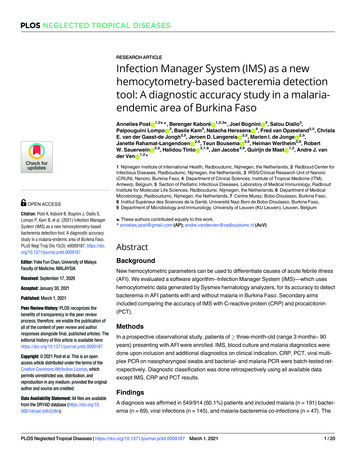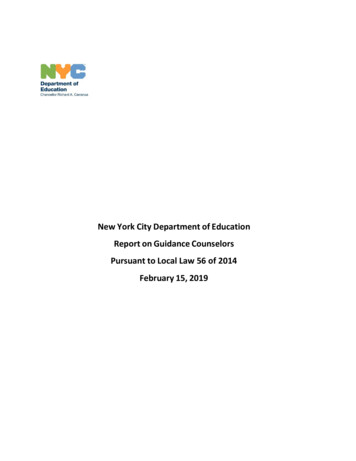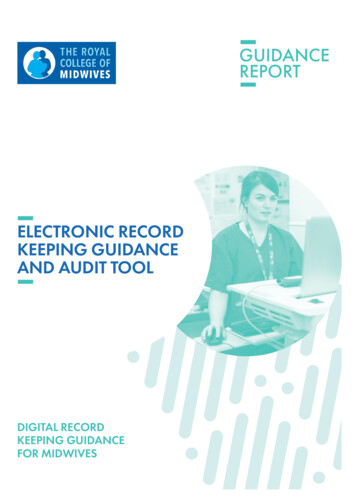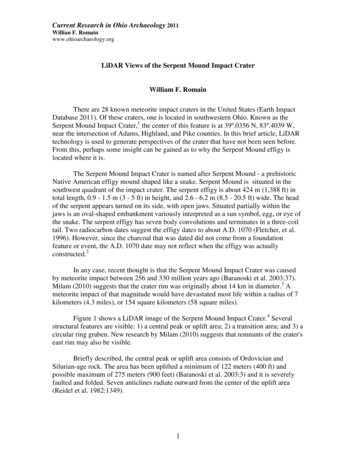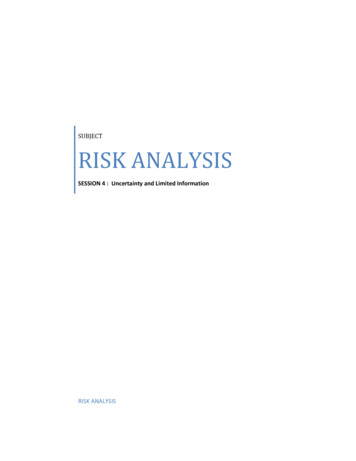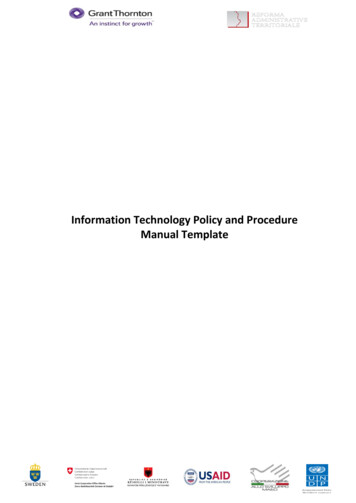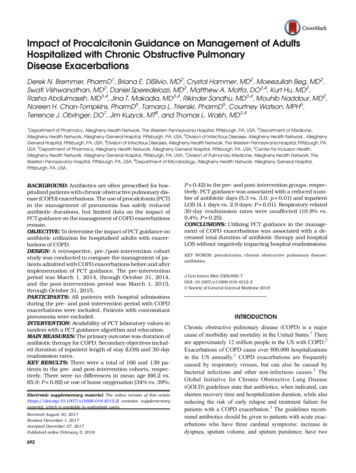
Transcription
Impact of Procalcitonin Guidance on Management of AdultsHospitalized with Chronic Obstructive PulmonaryDisease ExacerbationsDerek N. Bremmer, PharmD1, Briana E. DiSilvio, MD2, Crystal Hammer, MD2, Moeezullah Beg, MD2,Swati Vishwanathan, MD2, Daniel Speredelozzi, MD2, Matthew A. Moffa, DO3,4, Kurt Hu, MD2,Rasha Abdulmassih, MD3,4, Jina T. Makadia, MD3,4, Rikinder Sandhu, MD3,4, Mouhib Naddour, MD2,Noreen H. Chan-Tompkins, PharmD5, Tamara L. Trienski, PharmD5, Courtney Watson, MPH6,Terrence J. Obringer, DO7, Jim Kuzyck, MT8, and Thomas L. Walsh, MD3,41Department of Pharmacy, Allegheny Health Network, The Western Pennsylvania Hospital, Pittsburgh, PA, USA; 2Department of Medicine,Allegheny Health Network, Allegheny General Hospital, Pittsburgh, PA, USA; 3Division of Infectious Diseases, Allegheny Health Network , AlleghenyGeneral Hospital, Pittsburgh, PA, USA; 4Division of Infectious Diseases, Allegheny Health Network, The Western Pennsylvania Hospital, Pittsburgh, PA,USA; 5Department of Pharmacy, Allegheny Health Network, Allegheny General Hospital, Pittsburgh, PA, USA; 6Center for Inclusion Health,Allegheny Health Network, Allegheny General Hospital, Pittsburgh, PA, USA; 7Division of Pulmonary Medicine, Allegheny Health Network, TheWestern Pennsylvania Hospital, Pittsburgh, PA, USA; 8Department of Microbiology, Allegheny Health Network, Allegheny General Hospital,Pittsburgh, PA, USA.BACKGROUND: Antibiotics are often prescribed for hospitalized patients with chronic obstructive pulmonary disease (COPD) exacerbations. The use of procalcitonin (PCT)in the management of pneumonia has safely reducedantibiotic durations, but limited data on the impact ofPCT guidance on the management of COPD exacerbationsremain.OBJECTIVE: To determine the impact of PCT guidance onantibiotic utilization for hospitalized adults with exacerbations of COPD.DESIGN: A retrospective, pre-/post-intervention cohortstudy was conducted to compare the management of patients admitted with COPD exacerbations before and afterimplementation of PCT guidance. The pre-interventionperiod was March 1, 2014, through October 31, 2014,and the post-intervention period was March 1, 2015,through October 31, 2015.PARTICIPANTS: All patients with hospital admissionsduring the pre- and post-intervention period with COPDexacerbations were included. Patients with concomitantpneumonia were excluded.INTERVENTION: Availability of PCT laboratory values intandem with a PCT guidance algorithm and education.MAIN MEASURES: The primary outcome was duration ofantibiotic therapy for COPD. Secondary objectives included duration of inpatient length of stay (LOS) and 30-dayreadmission rates.KEY RESULTS: There were a total of 166 and 139 patients in the pre- and post-intervention cohorts, respectively. There were no differences in mean age (66.2 vs.65.9; P 0.82) or use of home oxygenation (34% vs. 39%;Electronic supplementary material The online version of this article(https://doi.org/10.1007/s11606-018-4312-2) contains supplementarymaterial, which is available to authorized users.Received August 30, 2017Revised December 1, 2017Accepted December 27, 2017Published online February 5, 2018692P 0.42) in the pre- and post-intervention groups, respectively. PCT guidance was associated with a reduced number of antibiotic days (5.3 vs. 3.0; p 0.01) and inpatientLOS (4.1 days vs. 2.9 days; P 0.01). Respiratory-related30-day readmission rates were unaffected (10.8% vs.9.4%; P 0.25).CONCLUSIONS: Utilizing PCT guidance in the management of COPD exacerbations was associated with a decreased total duration of antibiotic therapy and hospitalLOS without negatively impacting hospital readmissions.KEY WORDS: procalcitonin; chronic obstructive pulmonary disease;antibiotics.J Gen Intern Med 33(5):692–7DOI: 10.1007/s11606-018-4312-2 Society of General Internal Medicine 2018INTRODUCTIONChronic obstructive pulmonary disease (COPD) is a majorcause of morbidity and mortality in the United States.1 Thereare approximately 12 million people in the US with COPD.2Exacerbations of COPD cause over 800,000 hospitalizationsin the US annually.2 COPD exacerbations are frequentlycaused by respiratory viruses, but can also be caused bybacterial infections and other non-infectious causes.3 TheGlobal Initiative for Chronic Obstructive Lung Disease(GOLD) guidelines state that antibiotics, when indicated, canshorten recovery time and hospitalization duration, while alsoreducing the risk of early relapse and treatment failure forpatients with a COPD exacerbation.3 The guidelines recommend antibiotics should be given to patients with acute exacerbations who have three cardinal symptoms: increase indyspnea, sputum volume, and sputum purulence; have two
JGIMBremmer et al.: Impact of Procalcitonin on COPD Exacerbationsof the cardinal symptoms, if increased purulence of sputum isone of the two symptoms; or require mechanical ventilation.3As a result of the guideline recommendations, antibioticsare often prescribed for hospitalized patients with COPDexacerbations.4 Interestingly, the European Society for Clinical Microbiology and Infectious Diseases describes nonpneumonic COPD exacerbations to be triggered primarily byviruses.5 Indeed, Lieberman and colleagues found patientswith exacerbated COPD to be infected with viruses 46% ofthe time.6 Therefore, the common practice of prescribingantibiotics based on these subjective criteria is likely to leadto unnecessary overuse of antibiotics.4 As antibiotic resistanceis becoming a serious threat to public health,7 antimicrobialstewardship programs (ASPs) have a significant opportunityto reduce antibiotic utilization in this commonly encountereddisease state. One approach for ASPs is to utilize biomarkersable to distinguish bacterial causes from viral or noninfectious etiologies as the trigger for an episode of exacerbated COPD. Procalcitonin (PCT) is a biomarker specific tobacterial pathogens, and use of PCT-guided algorithms hasdemonstrated an ability to reduce antibiotic exposure in patients with pneumonia without negatively impacting clinicaloutcomes in randomized controlled studies.8,9 In response tobacterial-induced cytokines, PCT is released ubiquitously intothe bloodstream.10 Conversely, production is attenuated bycytokines released in response to viral infections.11,12 Therefore, PCT helps distinguish between systemic bacterial infections and other inflammatory reactions or viral infections.There are few studies in the literature evaluating PCT in themanagement of COPD exacerbations.13,14 The goal of thisstudy was to show the real-world impact of a PCT-guidedalgorithm on antibiotic utilization in adult patients hospitalizedwith COPD exacerbations.PATIENTS AND METHODSStudy Setting and PopulationThe study took place at two teaching hospitals in Pittsburgh,Pennsylvania. Allegheny General Hospital (AGH) is a 631bed quaternary care teaching facility with approximately22,000 inpatient admissions yearly. The Western PennsylvaniaHospital (WPH) is a 317-bed community-based teaching hospital with nearly 6800 inpatient admissions annually. Thequality assurance evaluation was granted exempt status fromthe Institutional Review Board.Study DesignWe conducted a retrospective, pre-/post-intervention studycomparing the management of patients admitted withCOPD exacerbations before and after implementation ofa PCT guidance initiative. The pre-intervention periodwas March 1, 2014, through October 31, 2014, and the693post-intervention period was March 1, 2015, through October 31, 2015.InterventionOur ASP worked with our microbiology laboratory to beginperforming in-house PCT concentrations on March 1, 2015, inan effort to help distinguish bacterial etiologies from viralpathogens and non-infectious causes of COPD exacerbationsand community acquired pneumonia. Our ASP created aclinical decision-making algorithm for suspected bacterial respiratory tract infections, including COPD exacerbations(Online Supplementary Fig. 1). The algorithm was approvedby our ASP, Antimicrobial Subcommittee of the Pharmacyand Therapeutics Committee, and Pharmacy and TherapeuticsCommittee. For patients admitted with a COPD exacerbation,we recommended obtaining a PCT concentration within 24 h.For those with a concentration 0.1 μg/l or 0.1–0.25 μg/l,initiation of antibiotic therapy was strongly discouraged anddiscouraged, respectively. If antibiotics were withheld, werecommended repeating PCT testing 6–24 h later. For patientswith initial PCT concentrations 0.25–0.5 μg/l and 0.5 μg/l,initiation of antibiotic therapy was recommended and stronglyrecommended, respectively. If antibiotic therapy was initiated,the recommended total duration was 5–7 days as indicated bythe guidelines.3 The algorithm was implemented as a guideand antimicrobial prescribing was subject to the primary treatment team’s decision.To inform the providers of our hospitals about the use ofPCT, our ASP performed several educational steps. An electronic mail was sent from our Chair of Pathology, Director ofMicrobiology, and Medical Director of ASP to all house staffand medical staff notifying providers that PCT was availableto order as a clinical tool while providing background information, clinical trial data, and the proposed role for PCT atAGH and WPH. We disseminated the clinical decisionmaking algorithm to all medical and house staff via electronicmail and incorporated it into our yearly Antimicrobial Guide,which is made available in print and on our network’s intranet.Laminated copies were posted at nursing units, physicianwork areas, the Emergency Department (ED), and the InternalMedicine residency department. A bi-folded 4 5 pocketcard was created and distributed to the Internal Medicineresidents. Lastly, we presented educational lectures to theInternal Medicine residency house staff, Internal Medicinemedical staff, the Department of Hospitalist medicine, Department of Emergency medicine, Division of Pulmonary andCritical Care medicine, and the Division of InfectiousDiseases.Measurement of Serum PCTPCT concentrations were measured using an automated heterogeneous sandwich immunoassay with fluorescence detection (VIDAS B.R.A.H.M.S. PCT assay; bioMérieux, MarcyL’Etoile, France). Total assay time was 20 min with a
694JGIMBremmer et al.: Impact of Procalcitonin on COPD Exacerbationsmeasuring range of 0.05 to 200 μg/l and a functional sensitivity of 0.09 μg/l.15PCT was available in the Microbiology Laboratory 24 h perday and 7 days per week. Tests were run as needed. Whenordered STAT from the AGH ED, results were availablewithin 90 min. When ordered from other locations at AGHor WPH, results were made available during the same shift,usually within 6 h.Data CollectionFor the pre-intervention period, we identified all patients witha primary diagnosis of COPD exacerbation using the International Classification of Diseases, Ninth Revision (ICD-9),coding data. The search codes included acute bronchitis(466), chronic bronchitis (490–491), emphysema (492), andchronic airway obstruction (496) and ICD-10 codes: acutebronchitis (J20), unspecified chronic bronchitis (J42), emphysema (J34), and other chronic obstructive pulmonary disease(J44). These data were electronically extracted via our QualityIntelligence department.For the post-intervention period, we included all patientswho had a PCT concentration obtained within 24 h of admission with an admitting diagnosis of COPD. For patients withmultiple hospitalizations, only the first admission was included. Demographic information, admission and discharge dates,and hospital length of stay (LOS) were extracted electronicallyvia our Quality Intelligence department. Study investigatorsverified the admission diagnosis and obtained informationregarding patient comorbidities, microbiologic data, radiographic studies, inpatient and outpatient antimicrobial therapy,and subsequent inpatient clinical encounters at AGH andWPH during the 30 days following hospital discharge viareview of the electronic medical record.Patients were excluded for age 18 years, PCT concentration not obtained within 24 h of admission, transfer from anoutside hospital, left against medical advice, death duringindex hospitalization, concomitant non-pulmonary bacterialinfection that required antibiotic therapy, neutropenia, severecell-mediated immunodeficiency, admission to the intensivecare unit, receipt of mechanical ventilation, and identified tohave pneumonia by imaging or if investigators were unable todetermine the duration of antibiotics prescribed upondischarge.group, we compared duration of therapy for patients with lowPCT concentrations ( 0.25 μg/l) versus patients with elevatedPCT concentrations ( 0.25 μg/l). Another subset of the postintervention group included only those with a low PCT concentration and compared inpatient length of stay and hospitalreadmission rates among patients who received 1 day or less ofazithromycin to those who received 1 day of azithromycin.Severe immunodeficiency was defined as use of chronicimmunosuppressive therapy at the time of admission (equivalent of 10 mg prednisone daily), human immunodeficiencyvirus with CD4 cell count 350 cells/mm3, active malignancywith receipt of systemic chemotherapy within the 30 daysprior to index admission, or receipt of prior solid organ transplant or hematopoietic stem cell transplantation.Data AnalysisDifferences between the pre- and post-intervention cohorts forcontinuous variables were assessed using the two-sample ttest. Differences in categorical data were assessed using chisquared or Fisher’s exact test as appropriate. P 0.05 wasconsidered statistically significant. Stata statistical software,version 12, was used for data analysis.RESULTSThere were a total of 166 and 139 patients in the pre- and postintervention groups, respectively. Baseline demographics canbe seen in Table 1.The mean duration of antibiotic therapy decreased in thepost-intervention group (5.3 vs. 3.0 days; P 0.01) (Table 2).The number of patients who received 0–1 days of antibiotictherapy increased in the post-intervention group (14.5% vs.43.8%; P 0.01). Additionally, patients in the postintervention group had a shorter duration of IV antibiotictherapy (2.5 vs. 1.9 days; P 0.02) and a reduction of theirhospital LOS (4.1 vs. 2.9 days; P 0.01) (Table 2). There wasno difference in hospital readmissions (14.5% vs. 16.6%; P 0.25) or respiratory-related readmissions (10.8% vs. 9.4%;P 0.18) between groups.In the post-intervention cohort, no patients who were initially admitted to a general medical/surgical floor requiredtransfer to an ICU later in the hospitalization. Additionally,Table 1 Baseline DemographicsStudy Outcomes and DefinitionsThe primary outcome was to compare the duration of antibiotic therapy before and after the implementation of PCTguidance for the management of COPD exacerbations. Duration of therapy included in- and outpatient antibiotics prescribed to be administered.Secondary outcomes included the duration of intravenous(IV) antibiotic treatment, duration of inpatient LOS, and allcause hospital readmission as well as respiratory-related readmission within 30 days of discharge. In the post-interventionCharacteristicPreintervention(n 166)Postintervention(n 139)PvalueAge, years (SD)Female sex, n (%)Race, n (%)CaucasianAfrican AmericanOtherUse of home oxygen,n (%)66 (12.6)92 (55.4%)66 (13.3)94 (67.6%)0.820.030.46103 (62.1%)55 (33.1%)8 (4.8%)57 (34.3%)89 (64.0%)47 (33.8%)3 (2.2%)54 (38.9%)SD, Standard deviation; data presented as means0.42
JGIMBremmer et al.: Impact of Procalcitonin on COPD ExacerbationsTable 2 Antibiotic Durations and Secondary Outcomes of TotalCohortVariablePreintervention(n 166)5.3 (3.2)Duration of totalantibiotics, mean (SD),days2.5 (2.4)Duration of IVantibiotics, mean (SD),daysTotal antibiotic duration, n (%)0 to 1 day24 (14.5)2 to 5 days73 (44.0)6 to 7 days37 (22.3)8 to 10 days23 (13.8)11 to 14 days8 (4.8)More than 14 days1 (0.6)Inpatient LOS, mean4.1 (3.9)(SD), daysAll-cause 30-day read24 (14.5)mission, n (%)Respiratory-related 3018 (10.8)day readmission, n (%)Postintervention(n 139)Pvalue3.0 (2.9)0.011.9 (1.8)0.0261 (43.8)48 (34.6)18 (13.0)10 (7.2)2 (1.4)0 (0)2.9 (2.0)0.0123 (16.6)0.2513 (9.4)0.18with a low PCT who received 1 day of azithromycin, themean duration of total antibiotic therapy was 4.7 days. Theyreceived a median of 5.0 days of antibiotic therapy with aninterquartile range (IQR) of 3.0–6.0 days. There was no difference in readmission rates between those who received 0–1 days of azithromycin compared to those who received 1 day of azithromycin therapy (17.4% vs. 18.5%; P 0.87).There was a shorter hospital LOS in the patients who received0–1 days of azithromycin (2.5 vs. 3.3 days; P 0.03). Ofpatients who had an initial low PCT level in the postintervention cohort, only 11 had a PCT level repeated within24 h of the initial level. Of these 11 who had a repeat PCT, 10had consecutive low levels, while only 1 who had an initiallow level had a repeat level that was elevated within the next24 h.DISCUSSIONSD, Standard deviation; IV, intravenous; LOS, length of stayno patients who were initially admitted to a general medical/surgical floor died during their hospitalization or in the 30 daysfollowing the index hospitalization. Also, in the postintervention cohort, none of the patients who did not receiveantibiotic therapy within the initial 48 h ended up receivingantibiotic therapy later in their hospital course.In the post-intervention group, 11.5% (16/139) of patientshad an elevated PCT ( 0.25 μg/l). Patients with an elevatedPCT received longer durations of antibiotics compared tothose with low PCT concentrations (5.3 vs. 2.7 days; P 0.01). Other outcomes comparing this subset can be seen inTable 3. Among patients with a low PCT, 69 and 54 patientsreceived 0–1 days of azithromycin and 1 days ofazithromycin therapy, respectively. In the group of 54 patientsTable 3 Post-Intervention Analysis Comparing Low and ElevatedPeak Procalcitonin ConcentrationsPvalueVariablePeakprocalcitonin 0.25 μg/l(n 123)Peakprocalcitonin 0.25 μg/l(n 16)Duration of totalantibiotics, mean (SD),daysDuration of IVantibiotics, mean (SD),daysTotal antibiotic duration,0 to 1 day2 to 5 days6 to 7 days8 to 10 days11 to 14 daysMore than 14 daysInpatient LOS, mean(SD), daysAll-cause 30-day readmission, n (%)Respiratory related 30day readmission, n (%)2.7 (2.8)5.3 (3.2)0.011.8 (1.8)2.7 (1.7)0.06n (%)58 (47.2)43 (35.0)15 (12.2)6 (4.9)1 (0.7)0 (0)2.9 (1.9)3 (18.7)5 (31.3)3 (18.8)4 (25.0)1 (6.2)0 (0)3.6 (2.8)0.1622 (17.9)1 (6.3)0.4713 (10.6)0 (0)0.36SD, Standard deviation; IV, intravenous; LOS, length of stay695Our study showed that the implementation of PCT guidancefor the management of COPD exacerbations was significantlyassociated with a reduction in the duration of antibiotic therapy. In this real-world experience, PCT utilization proved to bea useful tool to determine which patients should be prescribedantibiotics. Prior to PCT guidance, practitioners relied solelyon the GOLD guidelines criteria, with one of the key components being sputum purulence, which may not be specific foridentifying bacterial compared to viral etiologies.16 To quotethe American College of Physicians and the Centers for Disease Control and Prevention, BDetermining whether a patienthas a viral or non-viral cause can be difficult. The presence ofpurulent sputum or a change in its color does not signifybacterial infection; purulence is due to the presence of inflammatory cells or sloughed mucosal epithelial cells. 16 Giventhat there was no difference in hospital readmissions betweengroups, we believe PCT guidance represents an objectivecriterion that can be safely utilized to reduce total antibioticexposure for patients with this disease state.Antibiotic use in exacerbated COPD is thought to decreasethe hospital LOS.3 Interestingly, we found a decreased LOS inour post-intervention group of patients who received lessantibiotic exposure by utilizing PCT guidance. This findingfurther solidifies the effectiveness of PCT guidance to safelydecide which patients might benefit from antibiotic treatment.Our study is unique in that it shows PCT guidance to beuseful in a real-world practice when accompanied by a clinicaldecision-making algorithm. Other studies evaluating PCTguidance for patients with COPD exacerbations have primarily been in a controlled setting. One of those studies, theProHOSP study, was a prospective randomized controlled trialthat included patients with pneumonia and COPD exacerbations.14 Among the cohort with exacerbated COPD, there wasa significant reduction in antibiotic exposure from 5.1 days to2.5 days, without an increased incidence of combined adverseoutcomes.14 A recent meta-analysis of 8 trials evaluating 1062
696Bremmer et al.: Impact of Procalcitonin on COPD Exacerbationspatients with acute exacerbated COPD found that PCT-basedprotocols decreased total antibiotic exposure by 3.83 dayswithout affecting clinical outcomes such as rate of treatmentfailure, length of hospitalization, exacerbation recurrence rate,or mortality.17 All eight included studies were randomized orquasi-randomized controlled trials comparing PCT-based versus standard protocols to guide antibiotic use. Similar to thesecontrolled trials, our real-world experience was associatedwith a reduction in antibiotic exposure for patients with thisdisease state without negatively affecting readmission rates.Additionally, in our study, only 11.5% of included patients inthe post-intervention cohort had an elevated PCT level. This isconsistent with prior studies that also found 20% or less ofpatients hospitalized with exacerbated COPD had an elevatedPCT level.18,19 These consistent findings suggest that themajority of COPD exacerbations leading to hospitalizationare due to non-bacterial etiologies.The GOLD guidelines state that PCT guidance may not be acost-effective test to utilize routinely for COPD exacerbations.3 However, a recent cost analysis of predicted outcomesin COPD exacerbation patients found PCT guidance to be costeffective.20 Indeed, the LOS and antibiotic reductions seen inour cohort would offset the costs associated with PCTconcentrations.An unanticipated finding of this study was the use of shortcourse azithromycin despite a low PCT concentration in somepatients. We hypothesize that this could be due to prescriberdistrust of procalcitonin guidance or that azithromycin wasused for its pleiotropic effects including anti-inflammatoryproperties. While maintenance dosing of azithromycin,250 mg daily for 1 year, has shown a benefit in preventinghospital readmissions,21 there is no compelling evidence suggesting short-course azithromycin to have benefit. Our studyshowed no difference in readmissions and a shorter hospitalLOS for those who were not prescribed azithromycin. However, the low number of patients in this subset analysis maynot provide sufficient power to detect a difference. Furtherstudies are needed to evaluate the utility of a short-courseazithromycin treatment in patients who are hospitalized withexacerbated COPD and have a low PCT concentration.Our current evaluation has several limitations. First, it was aretrospective analysis, and therefore we were limited to the dataavailable in the electronic medical record. Additionally, patientsin the pre-intervention cohort were identified by ICD-9 codingfrom hospital discharge data, and this may have led to anunderestimation of the true number of hospitalized patients withCOPD exacerbations. In the post-intervention group, it is possible that patients with severe COPD exacerbations did not havea PCT concentration obtained as the treating physician wouldhave utilized antibiotics regardless of PCT result and thereforewould have not been identified for our analysis. Furthermore, apaucity of patients had a PCT level repeated in our postintervention cohort. Additionally, readmission data were limitedto AGH and WPH. Therefore, visits to other inpatient facilities,urgent care centers, and physicians’ outpatient offices may haveJGIMbeen missed. Lastly, our current analysis was only designed toevaluate clinically stable patients admitted with acute exacerbated COPD. Our institutional algorithm was not designed orintended to withhold antibiotics from patients with hemodynamic or respiratory instability. As our study aim was to evaluate the impact of this institutional PCT guidance algorithm, weonly were able to evaluate the impact of this algorithm onhospitalized stable patients. Thus, we excluded patients admitted to an intensive care unit or who were placed upon mechanical ventilation upon their admission. Therefore, our findingscannot be extrapolated to unstable patients with more severeCOPD exacerbations.CONCLUSIONSPatients with COPD exacerbations requiring hospitalizationhave a high readmission rate, and additional antibiotic exposures are likely.2,4 The repeated exposure of antibiotics in thispatient population can lead to antimicrobial resistance, whichis a serious threat to public health.7 Our study demonstratesthat the implementation of PCT guidance as part of a clinicaldecision-making algorithm is associated with reduced antibiotic exposures without negatively impacting hospitalreadmissions in the management of adult patients admittedwith COPD exacerbations.Corresponding Author: Thomas L. Walsh, MD; Division of InfectiousDiseases, Allegheny Health Network Allegheny General Hospital,Pittsburgh, PA, USA (e-mail: Thomas.Walsh@ahn.org).Contributors The authors thank Karen Kasarda for assistance withimplementation of procalcitonin guidance in the microbiology laboratory at Allegheny General Hospital.Funding This research received no specific grant from any fundingagency in the public commercial or not-for-profit sectors.Compliance with Ethical Standards:Prior Presentations: This work was presented at ID Week, October 7,2017.Conflict of Interest: The authors declare that they do not have aconflict of interest.REFERENCES1.2.3.4.Mannino DM, Kiriz VA. Changing the burden of COPD mortality. Int JChron Obstruct Pulmon Dis. 2006:1(3):219-233.Wier LM, Elixhauser A, Pfuntner A, Au DH. Overview of hospitalizationsamong patients with COPD, 2008: Statistical brief #106. Healthcare Costand Utilization Project (HCUP) Statistical Briefs. Rockville: Agency forHealthcare Research and Quality (US); 2006.Vogelmeier CF, Criner GJ, Martinez FJ, et al. Global Strategy for theDiagnosis, Management, and Prevention of Chronic Obstructive LungDisease 2017 Report. GOLD Executive Summary. Am J Respir Crit CareMed. 2017: 195(5):557-582.Lopez-Campos JL, Hartl S, Pozo-Rodriguez F, Roberts CM. AntibioticPrescription for COPD Exacerbations Admitted to Hospital: EuropeanCOPD Audit. PLoS One. 2015:10(4):e0124374.
JGIM5.6.7.8.9.10.11.12.13.Bremmer et al.: Impact of Procalcitonin on COPD ExacerbationsWoodhead M, Blasi F, Ewig S, et al. Guidelines for the management ofadult lower respiratory tract infections–full version. Clin Microbiol Infect.2011:17 Suppl 6:E1-59.Lieberman D, Lieberman D, Gelfer Y, et al. Pneumonic vsnonpneumonic acute exacerbations of COPD. Chest. 2002:122(4):12641270.Boucher HW, Talbot GH, Bradley JS, et al. Bad bugs, no drugs: noESKAPE! An update from the Infectious Diseases Society of America. ClinInfect Dis. 2009:48(1):1-12.Gogos CA, Drosou E, Bassaris HP, Skoutelis A. Pro- versus antiinflammatory cytokine profile in patients with severe sepsis: a marker forprognosis and future therapeutic options. J Infect Dis. 2000:181(1):176180.Haeuptle J, Zaborsky R, Fiumefreddo R, et al. Prognostic value ofprocalcitonin in Legionella pneumonia. Eur J Clin Microbiol Infect Dis.2009:28(1):55-60.Muller B, White JC, Nylen ES, Snider RH, Becker KL, Habener JF.Ubiquitous expression of the calcitonin-i gene in multiple tissues inresponse to sepsis. J Clin Endocrinol Metab. 2001:86(1):396-404.Christ-Crain M, Muller B. Biomarkers in respiratory tract infections:diagnostic guides to antibiotic prescription, prognostic markers andmediators. Eur Respir J. 2007:30(3):556-573.Linscheid P, Seboek D, Zulewski H, Keller U, Muller B. Autocrine/paracrine role of inflammation-mediated calcitonin gene-related peptideand adrenomedullin expression in human adipose tissue. Endocrinology.2005:146(6):2699-2708.Schuetz P, Muller B, Christ-Crain M, et al. Procalcitonin to initiate ordiscontinue antibiotics in acute respiratory tract infections. CochraneDatabase Syst Rev. z P, Christ-Crain M, Thomann R, et al. Effect of procalcitoninbased guidelines vs standard guidelines on antibiotic use in lowerrespiratory tract infections: the ProHOSP randomized controlled trial.JAMA. 2009:302(10):1059-1066.VIDAS B.R.A.H.M.S. Procalcitonin technical details. bioMérieux s-brahms-pct. AccessedDec 14 2017.Harris AM, Hicks LA, Qaseem A. Appropriate antibiotic use for acuterespiratory tract infection in adults: advice for high-value care from theAmerican College of Physicians and the Centers for Disease Control andPrevention. Ann Intern Med. 2016:164(6):425-434.Mathiodakis AG, Chatzimavridou-Grigoriadou V, Corlateanu A, et al.Procalcitonin to guide antibiotic administration in COPD exacerbations: ameta-analysis. Eur Respir Rev. 2017:26:160073.Verduri A, Luppi F, D’Amico R, et al. Antibiotic treatment of severeexacerbations of chronic obstructive pulmonary disease withprocalcitonin: a randomized noninferiority trial. PLoS One.2015;10:e0118241.Stolz D, Christ-Crain M, Bingisser R, et al. Antibiotic treatment ofexacerbations of COPD: a randomized, controlled trial comparingprocalcitonin-guidance with standard therapy. Chest. 2007;131:9-19.Van der Maas ME, Mantjes G, Steuten LM. Procalcitonin biomarkeralgorithm reduces antibiotic prescriptions, duration of therapy, and costsin chronic obstructive
Pennsylvania. Allegheny General Hospital (AGH) is a 631-bed quaternary care teaching facility with approximately ania Hospital (WPH) is a 317-bed community-based teaching hos-pital with nearly 6800 inpatient admissions annually. The quality assurance evaluation was granted exempt status from
